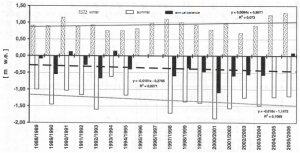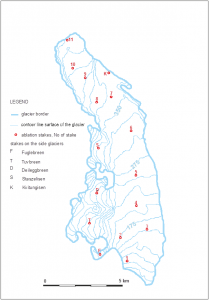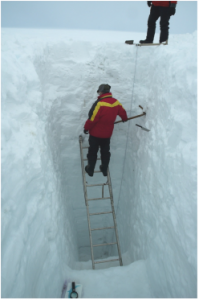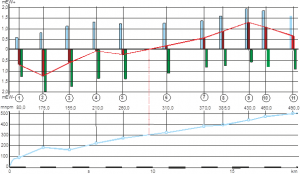Ablation stakes
Wooden or metal poles, immersed to a depth of a few meters in the ice. It is best to sink the stakes in the final period of ablation. In settled moments, the amount of snow or ice on the surface of successive stakes is measured. In the spring, in the vicinity of the stakes, snow pits are made to determine the amount of snowfall episodes, as well as types of fallen snow.
The line of snow stakes should cover the entire cross-section of the glacier. The measurement results may be summarized and illustrated graphically – for successive stakes, bar graphs can be made, for accumulation (shown blue in the figure), and ablation (shown green in the figure) separately. The red bar represents the result of the annual balance – which can be either positive or negative. On the basis of such juxtaposition one can determine a point on the glacier (on the cross-section, along the stakes line) where the balance is zero – this is the location of the Annual Equilibrium Line (ELA).
The location of this line may change in the subsequent years. If changes maintain constant direction, that is, if position of ELA lowers or rises systematically, climate changes may be deduced.
- Mass balance of Hans Glacier
- Map of ablation stakes
- Snow pit
- Mass balance of Hansa Glacier






 This project (EDU-ARCTIC) has received funding from the European Union’s Horizon 2020 research and innovation programme under grant agreement No 710240. The content of the website is the sole responsibility of the Consortium and it does not represent the opinion of the European Commission, and the Commission is not responsible for any use that might be made of information contained.
This project (EDU-ARCTIC) has received funding from the European Union’s Horizon 2020 research and innovation programme under grant agreement No 710240. The content of the website is the sole responsibility of the Consortium and it does not represent the opinion of the European Commission, and the Commission is not responsible for any use that might be made of information contained.